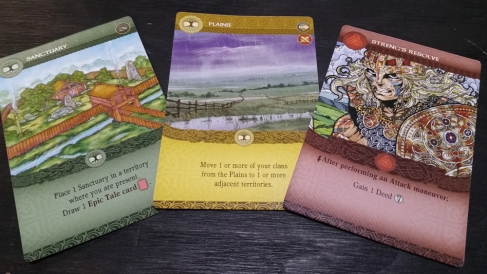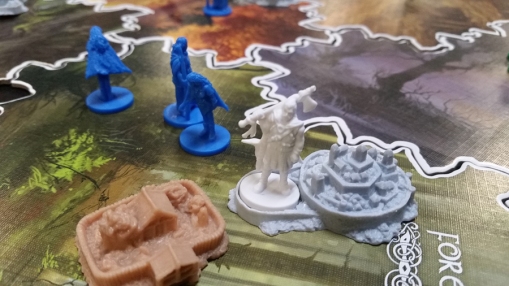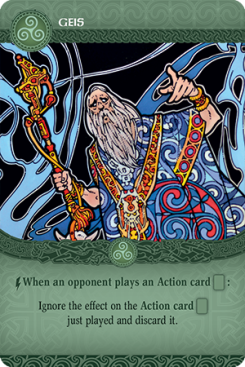
Photo from asmodee.us
Inis is a Celtic themed, area control game for 2 to 4 players that features beautiful artwork and wonderfully detailed miniatures. In Inis players draft action cards at the beginning of each round and then use these cards to build buildings, move miniatures around the board, and start battles. Rounds are played with players taking turns using their drafted cards to take actions until every player has passed.

Green action cards are the same (almost) every round and make up the majority of the players’ options for the round. Yellow action cards are given to the chieftain of each of the game’s modular map tiles; in the photo above the Plains action card is give to the player who has the most units on the Plains tile. Lastly the red action cards are Epic Tale cards that can be drawn in certain circumstances.

One of the best things about Inis is the absolutely top notch components. The map tiles are large, uniquely shaped, and gorgeous. Some of these tiles have certain play conditions that apply to units in that area, and each one has an action card that is added to the game when that tile comes into play. And while the map tiles are fantastic and add a lot to the strategy of the game, they pale in comparison to the awesomeness that is Inis’ miniatures.

The miniatures are amazingly well done, and as seen in the photo above can even interact with each other physically. This makes the game incredibly engaging both in a game play sense, and also on a tactile level. Inis is played (in a nutshell) by using action cards to manipulate one’s own miniatures on the board towards one of 3 win conditions. Players can win by:
- Being the chieftain (having the most character miniatures in a region) over six of the other players’ characters. In the example photo above the blue player is the chieftain of the Forest and has one of the white player’s miniatures counting toward this goal.
- Being in any number of regions that have a total of six sanctuaries. Sanctuaries are the light brown, shrine-looking miniature in the above photo. For example, a player can occupy 1 region with 3 sanctuaries, another with 2 sanctuaries, and a third region with a single sanctuary to satisfy this condition.
- Simply being present in six regions of the board.
These conditions sounded, to me, like they would be incredibly easy to fulfill. I was wrong.

Because of the drafting aspect of the game players are not able to do EXACTLY what they want to do each turn. Some of the game’s basic action cards allow the player to place more miniatures on the board, explore new areas of the map and draw a new board tile, start battles, etc. Sometimes, as is common in drafting games, players must choose to take a card that they know an opponent needs rather than pick something beneficial for themselves. #HateDrafting
On some turns when I have really needed to place more miniatures I have instead be forced to take the game’s most horrible, infuriating action card, the dreaded ‘Geis.’ At times the card I truly needed to reach my goal has been in my hand just waiting to be drafted, and instead I have had to defensively take this terrible, terrible card just so that my opponents cannot have it. If you play Inis and it isn’t amongst your first selection of cards in the draft you live in fear for the rest of the round. Your only thought is “Who has the Geis card?” Nothing can smite a well laid plan faster than Geis.

Photo from asmodee.us
Battles in Inis are critical and make excellent use of the castle-like citadels on the board. When another player initiates a battle the other players have the opportunity to shelter one of their units inside of a citadel, sparing that unit from the battle. Battles are performed not with dice but instead with action cards. Players attack back and forth and the defending player must either choose to suffer a casualty and remove a unit from the board OR discard a precious action card. This makes battles costly and critical since action cards are the key to staying in a round and units are vital to the game’s win conditions.
Many of the action cards allow players to move units from one region to another, and any more include a symbol that starts a clash/battle. With players moving their units across the board and with clashes being imminent, battles are very hard to avoid. As described above, they are also costly and can drastically change the lay of the land as far as victory conditions are concerned. A single, large battle can be a kingmaker moment.

Final Thoughts – Inis looks like a war game. The castles and warriors dotting the map are very misleading though, because while there are certainly battles it doesn’t feel like a normal board game clash. Inis feels like a psychological chess game played on a dynamic, modular board. Things go wrong, choices are taken away, battles are unavoidable, and difficult decisions are made at every turn. Players are forced to think far ahead and play for the long game, but unfortunately players do not know what tools will be available to them to reach this end. Is that a bad thing? No.
The same drafting mechanics that make formulating a plan difficult for you also work against your opponents. Regions on the map change hands and more are added as players explore. The action cards associated with the regions along with Epic Tale cards make predicting your opponents’ moves almost impossible. Players react to the cards they draft, their opponents’ cards, and even the order in which cards are played. Inis is a game all about reacting and adapting.
I personally identify more with the Eurogame style of play. I like to see my options and pursue my goals without worrying about direct opposition from my opponents. Oddly enough though, I tend to do better at games that take this option away from me, like Inis. Inis forces players to think on their feet, change directions, and go down a path they didn’t even consider several turns earlier. This adds a high level of stress to a game that looks so beautiful.
Sound like your type of game? If it does then the preceding description coupled with Inis’ beautiful artwork and high quality components will not disappoint. Just watch out for that Geis card!
